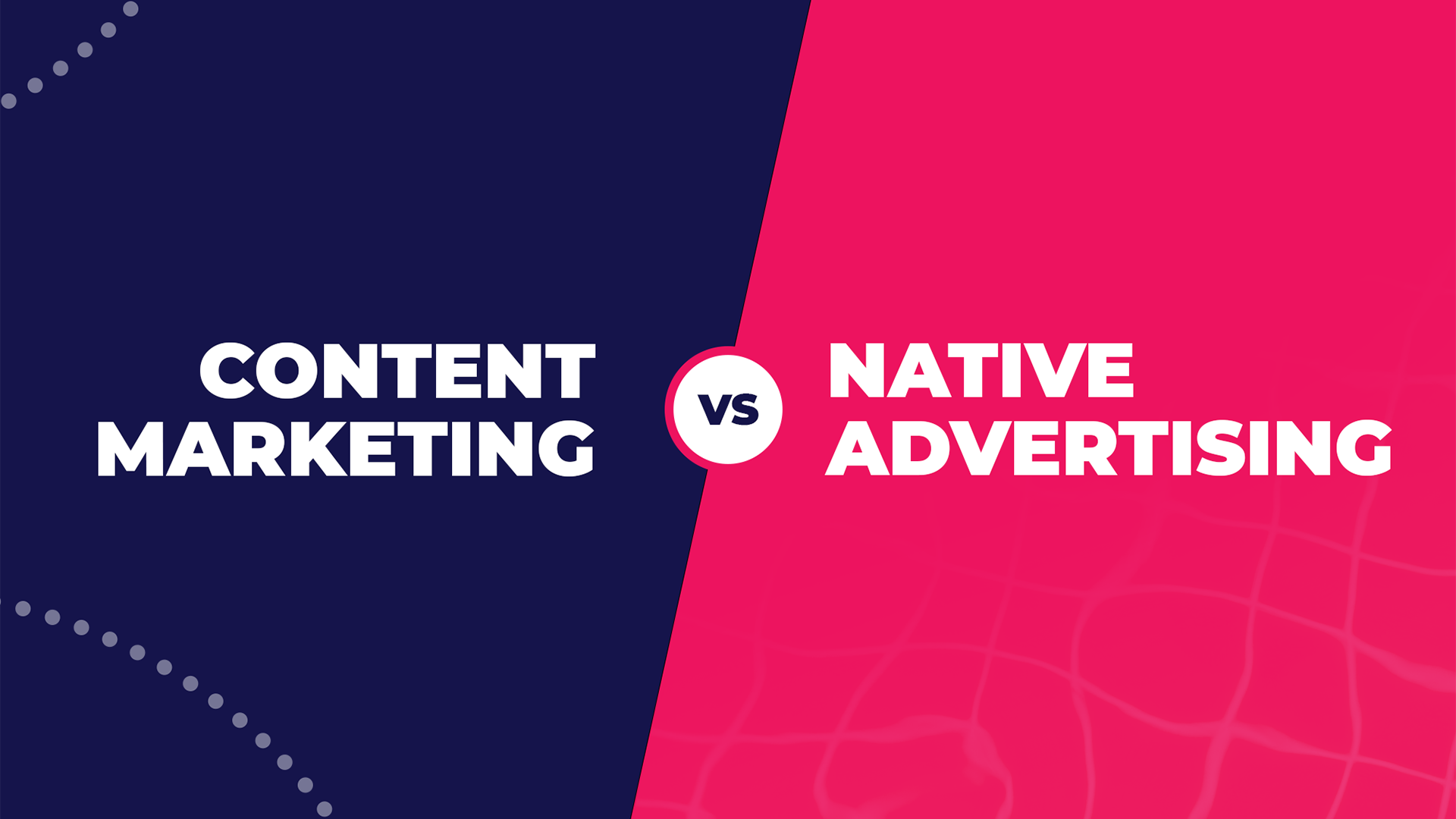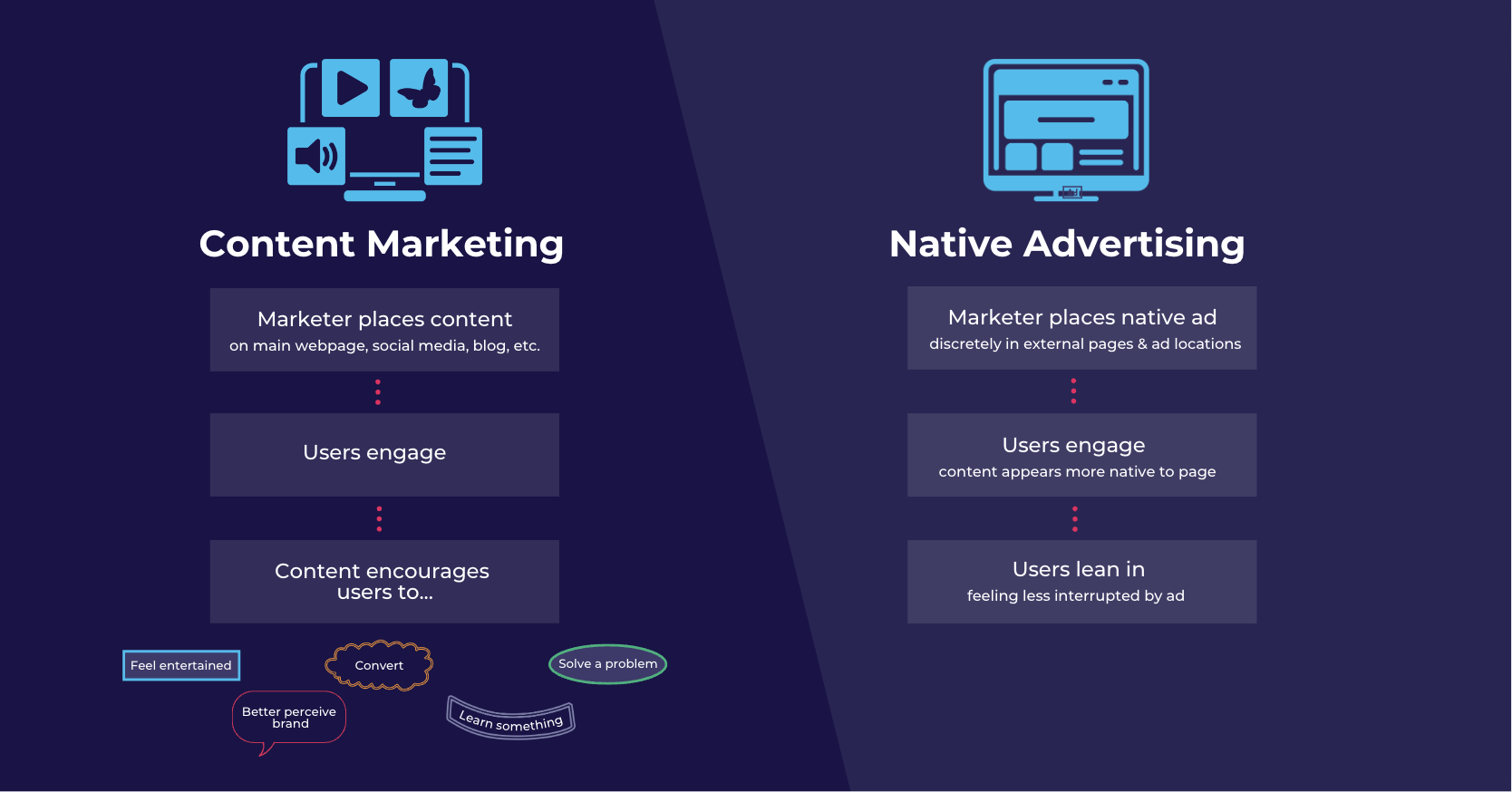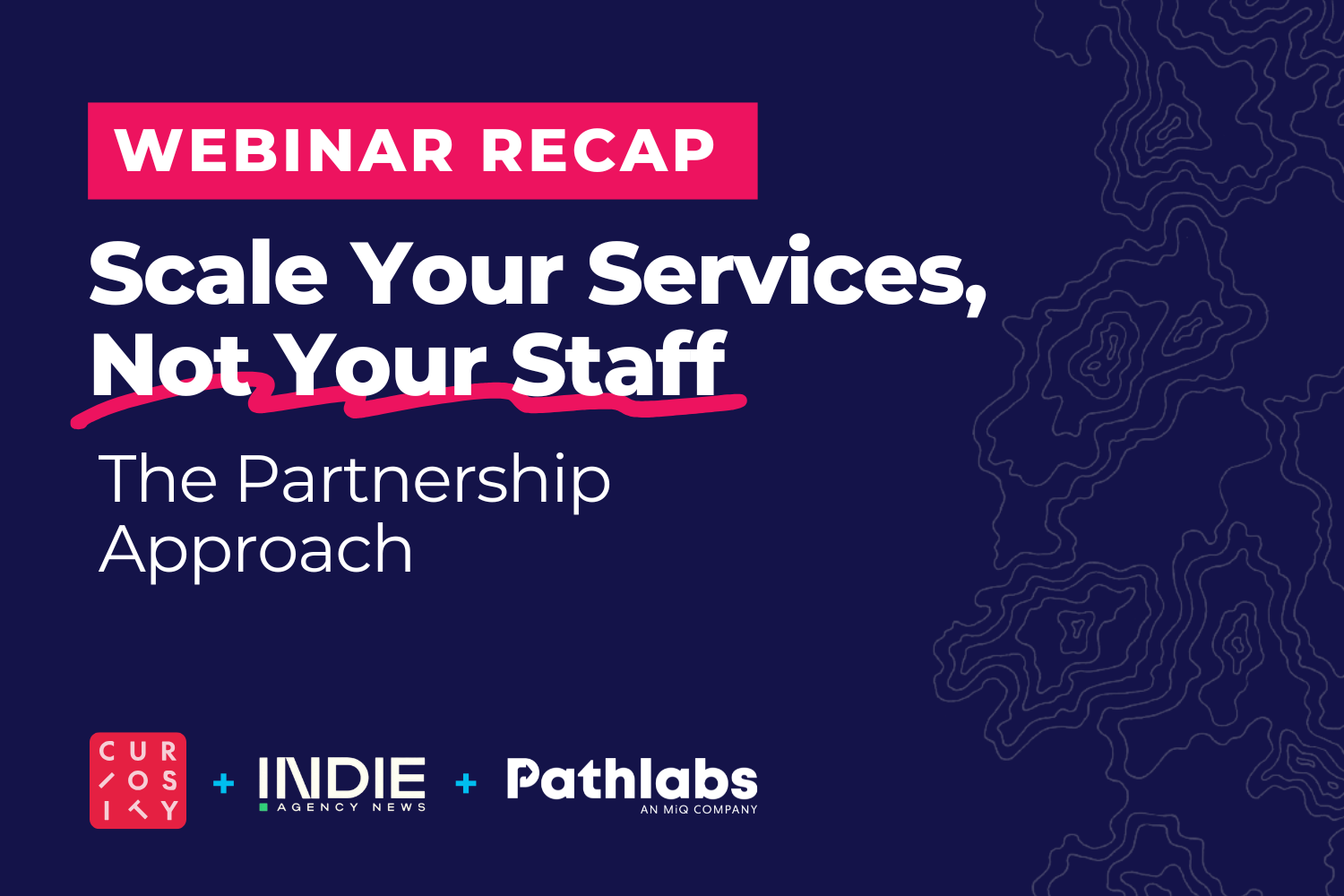Content Marketing vs. Native Advertising: A Deep-Dive Comparison
| Pathlabs Marketing |
| June 6, 2023 |
In a world where users crave authenticity and meaningful connections, traditional marketing methods can sometimes fall behind. That's where native and content marketing step in, paving the way for a gentler approach to customer engagement.
Join us as we delve into the fascinating realm of these two dynamic approaches. In this article, we’ll discover how these strategic powerhouses can elevate your brand, captivate your audience, and leave a lasting impact. Let's dive in!
The Key Difference Between Content Marketing vs. Native Advertising
Content marketing and native marketing differ in their approach. Content marketing involves the dissemination of valuable and informative content to users, whereas native marketing focuses on integrating advertisement content into the hosting page in a way that resembles and blends in with the surrounding context.
Marketers can fuse these methods together: placing valuable content that pulls users into paid native ad inventory slots.
“I like to think of content marketing as a pull method and paid marketing as a push method. With content marketing, you are pulling people to your site using the content itself. With paid media, like native, you are pushing your message out to an audience that might be searching for it (SEM), or it could just fall into the target market (native & other paid channels).”
What is Content Marketing?
Content marketing is a strategy that involves creating and distributing valuable, relevant, and engaging content to attract and retain a specific target audience.
Marketers commonly place this content on their web pages, social media accounts, and blogs to ‘pull’ in users.
“Content marketing stands out in its ability to consistently deliver valuable content, which can lead users to gain new knowledge, find value, and develop trust in the brand. This can result in repeat customers and potentially generate referrals from users who recommend the content to others.”
Purpose of Content Marketing
Content marketing aims to provide useful information, entertain, or educate the audience.
In effect, marketers shape a customer journey where users come across a piece of content, engage with it, and find some form of utility or value from it. Upon doing so, they have a positive association with the content piece itself and, hopefully, the company or brand that created it – maybe even converting or sharing it with their adjacent community.
Content Marketing Examples
Blog articles or guest posts
Infographics
Videos and webinars
E-books and whitepapers
Social media posts and updates
Podcasts
Newsletters
Advantages of Content Marketing
Content marketing offers several benefits to marketers. First, it enables them to create unique, engaging content that encourages interaction and sharing on social platforms. When the content is of high quality and relevance, it helps establish the brand as a credible and knowledgeable authority within the industry.
Additionally, content marketing often includes evergreen pieces that, once published, continue to attract users over a long period. As an example, this blog (yes, the one you’re reading now) serves as a form of content marketing and will remain relevant to users as long as content and native marketing exist, further strengthening the association of the topic with Pathlabs.
Lastly, content marketing is vital in improving search engine optimization (SEO). By consistently producing and sharing content, a brand increases its visibility in search engine results. This, in turn, creates more touchpoints in the sales funnel, enhancing the brand's overall online presence and driving potential customers to the website.
What is Native Advertising?
Native advertising refers to ads that imitate the form and function of the platform upon which they appear. The goal is to make the ad content look 'native' to the webpage, making users more likely to engage with it. According to a study by Sharethrough, users interact with native advertisements 53% more than standard display advertisements.
“Native marketing is a tactic where the ad content is structured to look and feel organic to the user. If run correctly, using native advertising can allow you to reach a user base that may not always click on a standard ad. They can be intriguing and draw people in to learn more about the matter presented in the ad.”
Purpose of Native Advertising
Native ads aim to provide a seamless user experience by blending in with the surrounding page or app content in style, format, and tone. By doing so, marketers hope to guide users through a customer journey where they browse and click on native ad content, perceiving it as a natural part of the page. The desired outcome is the user engaging and converting.
What we see here is native ads discretely capturing attention while also improving brand perception.
Native Advertising Examples
Sponsored articles or advertorials
Shopping ads
Recommendations
Search feed result ads
Promoted social media posts
Recommended content widgets
In-feed ads on websites or apps
Branded content on streaming platforms
“Native advertising blends seamlessly with its surroundings and can be run programmatically for display, video, and social media. They can also take a content approach, offering tips and industry-related information.”
Advantages of Native Advertising
Native advertising offers several advantages. One key benefit is that it avoids bombarding users with pop-ups or display ads, these can lead to "banner blindness", where users subconsciously ignore all ad content. Instead, native ads provide a gentler experience as they don't pressure users to click on them.
Another advantage is that native ads are designed to be device-responsive and are more compatible with ad blockers. This means users are less likely to encounter issues or disruptions while browsing the web.
Furthermore, according to Publift, a significant 75% of consumers tend to trust native ads more than traditional ads. This higher level of trust can lead to increased brand awareness and better engagement with the target audience.
Lastly, native ads can be easily deployed using programmatic platforms like Google Ads. This enables marketers to target their ads more accurately by leveraging user information and page context, improving ad relevance and effectiveness.
Similarities Between Content Marketing and Native Advertising
Both content and native advertising aim to engage audiences less abrasively. Native ads blend in and do not disrupt, while content marketing tries to attract users organically.
When marketers combine these approaches and place relevant content in native settings, they prioritize providing valuable information to the target audience. This strategy allows them to capture the audience's goodwill and tell a compelling brand story simultaneously.
Differences Between Native Advertising and Content Marketing
The key difference between content marketing and native marketing is that content marketing focuses on sharing valuable and informative content with users. In contrast, native focuses on merely placing ad content in a way that mimics and normalizes into the hosting page setting.
Think of content marketing as engaging and with substance. Think of native as discrete and assimilative.
Native ad content also errs on the side of being generic; the content blends in but still can be ‘advertisey’. Hence the fusion where marketers integrate a content marketing approach into their native ads, inputting blogs, articles, and more dynamic content instead.
Implementation will also differ. Native ads are typically implemented with programmatic platforms, social media, and other tools. While content marketers keep their content mostly organic, publishing it on their main touchpoints and letting engagement compound over time.
In effect, native advertising provides more control over targeting specific audiences and timely results, while content marketing has a broader reach and aims to reach audiences organically.
When to Use Content Marketing
Content marketing is not a one-time thing, instead, it should be implemented consistently over time. It is beneficial for those who want to develop a long-term relationship with their audience. By providing high-quality content, you can educate and nurture your audience effectively.
Furthermore, content marketing can be beneficial for improving your SEO performance and establishing brand credibility. You can achieve this by writing content on trendy topics relevant to your field and showcasing your expertise, ideally positioning your brand as a thought leader.
When to Use Native Advertising
Native advertising is a valuable tool for marketers seeking to move away from traditional and intrusive ad formats. It offers an alternative approach that blends seamlessly with the surrounding content, making it less disruptive to the user experience.
Marketers choose native advertising for its precise audience targeting and immediate results. By leveraging programmatic methods, campaigns can reach the right people at the right time. Programmatic platforms streamline the creation and distribution of native ads, ensuring a better user experience while effectively promoting products or services to the desired audience.
“Deciding when to use native vs. content marketing can be a case-by-case scenario. If the opportunity presents itself with the advertiser and industry, using one over the other can be beneficial, like the scenarios above. However, marketers shouldn’t shy away from using them in tandem together, for they can provide an integrated and full-funnel coverage campaign.”
Best Practices for Balanced Marketing Campaigns
Embrace Both Methods
Some teams may prefer native ads over content marketing or vice versa. However, combining both approaches can strengthen your marketing strategy. Native ads can target and guide mid to lower-funnel users to your landing page, while published content provides long-term engagement and covers the top of the funnel.
Understand this chunk of information and use it to your advantage.
Understand The Audience
To ensure effective content marketing and native advertising, it is essential to understand the audience. One way to achieve this is by creating audience personas, which are representative customer models based on relevant demographic and behavioral data.
Once the persona is established, marketers identify the most appropriate contexts where the audience will likely be present and strategically place ad content there.
Although developing the persona and placement strategy may require some experimentation, the effort put into optimizing these aspects is highly valuable.
Test and Optimize
Marketers should develop an optimization philosophy by continuously monitoring and analyzing content and native campaign performance.
Test and experiment with various ad formats, placements, headlines, and visuals to identify the most effective strategies. Utilize data-driven insights to optimize the campaign and make informed decisions that overall enhance its performance.
“At Pathlabs, we craft our optimization processes similar to The Scientific Method. First, we analyze a situation, ask ourselves questions, establish a hypothesis based on the data, and test. Next, we observe the test results, analyze them, then present our findings.”
Prioritize Quality Content
When combining native and content marketing, it is vital to prioritize creating top-notch, pertinent content that serves the purpose of educating, entertaining, or addressing the audience's problems.
Whether you create articles, videos, infographics, or interactive experiences, ensure that the content you deliver holds value and grabs the users' attention, fostering their engagement. Steer clear of hastily produced pieces and ensure that the quality of the content aligns with the brand's overall offerings.
In Conclusion
Both content marketing and native advertising are valuable tools for marketers. It is crucial to understand their distinctions and know when to employ each strategy to develop an effective marketing plan. By harnessing the strengths of both content marketing and native advertising, marketers can create impactful and successful campaigns that effectively connect with their intended audience and yield positive outcomes.

















